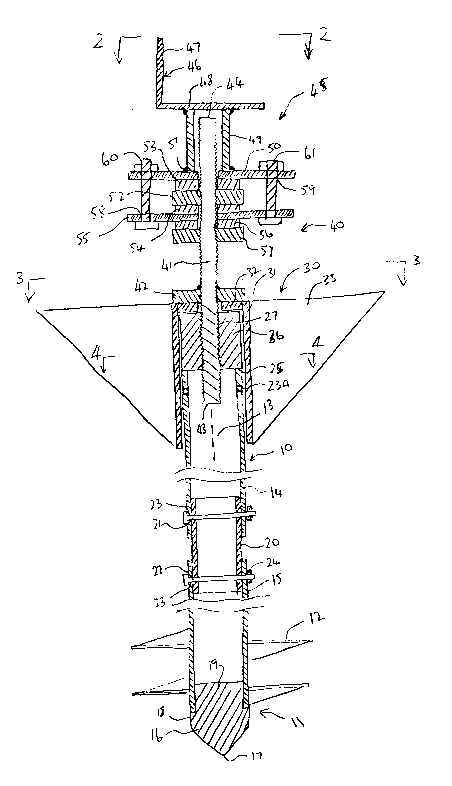Some of the information on this Web page has been provided by external sources. The Government of Canada is not responsible for the accuracy, reliability or currency of the information supplied by external sources. Users wishing to rely upon this information should consult directly with the source of the information. Content provided by external sources is not subject to official languages, privacy and accessibility requirements.
Any discrepancies in the text and image of the Claims and Abstract are due to differing posting times. Text of the Claims and Abstract are posted:
| (12) Patent Application: | (11) CA 2155504 |
|---|---|
| (54) English Title: | GROUND ANCHOR |
| (54) French Title: | DISPOSITIF D'ANCRAGE AU SOL |
| Status: | Deemed Abandoned and Beyond the Period of Reinstatement - Pending Response to Notice of Disregarded Communication |
| (51) International Patent Classification (IPC): |
|
|---|---|
| (72) Inventors : |
|
| (73) Owners : |
|
| (71) Applicants : | |
| (74) Agent: | ADE & COMPANY |
| (74) Associate agent: | |
| (45) Issued: | |
| (22) Filed Date: | 1995-08-04 |
| (41) Open to Public Inspection: | 1997-02-05 |
| Availability of licence: | N/A |
| Dedicated to the Public: | N/A |
| (25) Language of filing: | English |
| Patent Cooperation Treaty (PCT): | No |
|---|
| (30) Application Priority Data: | None |
|---|
A ground anchor comprises an elongate body with a flight at a
lower end of the body. The flight is a length of 24 inches and the elongate
body a length of the order of 8 feet and is formed by two tubes arranged end
to end coupled by a cylindrical sleeve pinned to the adjacent ends of the tubes.A winged stabilizer assembly includes a sleeve over an upper end of the
tubular body. The stabilizer assembly is clamped downwardly into the ground
by a nut welded to a threaded rod which engages into a second nut welded to
the top of the tube. The threaded rod is thus supported vertically upwardly
from the top of the tube and supports a mounting assembly. The mounting
assembly comprises a bracket having a base plate and a mounting plate
parallel to the base plate with a sleeve therebetween for receiving the upper
end of the threaded rod. A nut carries the mounting plate adjustably on the
threaded rod. A support plate parallel to the mounting plate is carried on a
second nut on the threaded rod. The mounting plate and the support plate are
clamped together by a pair of bolts parallel to the threaded rod.
Note: Claims are shown in the official language in which they were submitted.
Note: Descriptions are shown in the official language in which they were submitted.

2024-08-01:As part of the Next Generation Patents (NGP) transition, the Canadian Patents Database (CPD) now contains a more detailed Event History, which replicates the Event Log of our new back-office solution.
Please note that "Inactive:" events refers to events no longer in use in our new back-office solution.
For a clearer understanding of the status of the application/patent presented on this page, the site Disclaimer , as well as the definitions for Patent , Event History , Maintenance Fee and Payment History should be consulted.
| Description | Date |
|---|---|
| Application Not Reinstated by Deadline | 1999-08-04 |
| Time Limit for Reversal Expired | 1999-08-04 |
| Deemed Abandoned - Failure to Respond to Maintenance Fee Notice | 1998-08-04 |
| Inactive: Delete abandonment | 1997-10-02 |
| Letter Sent | 1997-08-28 |
| Deemed Abandoned - Failure to Respond to Maintenance Fee Notice | 1997-08-26 |
| Reinstatement Requirements Deemed Compliant for All Abandonment Reasons | 1997-08-12 |
| Deemed Abandoned - Failure to Respond to Maintenance Fee Notice | 1997-08-04 |
| Application Published (Open to Public Inspection) | 1997-02-05 |
| Abandonment Date | Reason | Reinstatement Date |
|---|---|---|
| 1998-08-04 | ||
| 1997-08-26 | ||
| 1997-08-04 |
The last payment was received on 1997-08-12
Note : If the full payment has not been received on or before the date indicated, a further fee may be required which may be one of the following
Please refer to the CIPO Patent Fees web page to see all current fee amounts.
| Fee Type | Anniversary Year | Due Date | Paid Date |
|---|---|---|---|
| MF (application, 2nd anniv.) - small | 02 | 1997-08-04 | 1997-08-12 |
| Reinstatement | 1997-08-12 |
Note: Records showing the ownership history in alphabetical order.
| Current Owners on Record |
|---|
| JAMES MAXWELL WILSON |
| Past Owners on Record |
|---|
| None |